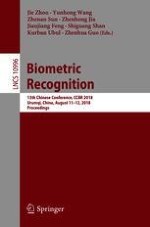2018 | Buch
Biometric Recognition
13th Chinese Conference, CCBR 2018, Urumqi, China, August 11-12, 2018, Proceedings
herausgegeben von: Prof. Jie Zhou, Yunhong Wang, Prof. Zhenan Sun, Zhenhong Jia, Dr. Jianjiang Feng, Shiguang Shan, Kurban Ubul, Prof. Dr. Zhenhua Guo
Verlag: Springer International Publishing
Buchreihe : Lecture Notes in Computer Science
